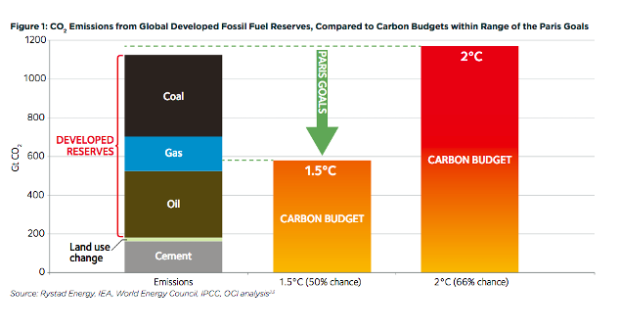Advertisement
Projects like Ohio State University’s natural gas plant, Columbia Gas’s Northern Loop natural gas pipeline and its Marysville Connecter natural gas pipeline are all due to be completed in the coming years. This comes at a time when climate scientists say aiming for net-zero emissions is essential for stopping the irreversible consequences of climate change.
Ohio continues to invest in renewable energy, but both the state and private sector are still largely pushing natural gas as essential for economic growth and championing it as “clean energy.” But, as a 2019 study found, natural gas is not a cheap or clean energy source.
Columbia Gas of Ohio’s Northern Loop and Marysville gas pipelines both aim to boost the industrial and residential areas of Union County and Marysville. Union County is home to a Honda factory, other auto companies (the county produces the most automobiles in Ohio) and will be home to a new Amazon Web Services location. Union County also has one of the fastest growing housing markets in the country. All require more energy and heat and Columbia Gas plans to meet these needs with the proposed pipelines, which will transfer gas from the east of Franklin County to these areas that lack natural gas.
In a Public Utilities Commission of Ohio (PUCO) hearing last week, Union County Commissioner Christiane Schmenk praised the proposed Northern Loop pipeline as essential for meeting the needs of the growing county.
“We believe that natural gas is essential to smart growth,” Schmenk said. “Natural gas is clean, reliable, affordable and abundant in many places. However, this is not true currently in Union County.”
A 2019 study done by Oil Change International (OCI) emphasized that while natural gas generates less emissions compared to oil and coal, natural gas still generates emissions that puts us way over the 50-year goal of net-zero emissions required to avoid the irreversible effects of climate change.
Methane leaks are a common occurrence when extracting gas through fracking and Ohio’s laxed laws allow companies to frack with little liability to the public. In 2018 a natural gas well blowout in eastern Ohio by an ExxonMobil subsidiary XTO Energy was tracked via satellite and labeled a “super-emitter.” The blowout went out of control leaking more methane in 20 days than most European countries do in a year.
But even ignoring the risk of methane leaks – which is a serious environmental concern, especially considering the Northern Loop pipeline will go under the Scioto River – natural gas emissions are still high and investments in it highlight a trend away from clean energy.
The 2019 OCI study found that investing in natural gas production and distribution isn’t clean or a “bridge” to a stable climate, but it instead “locks in” emissions for the decades that the infrastructure will last. If a municipality relies on natural gas and millions of dollars are invested into maintaining that industry, there’s little economic incentive to invest in renewable alternatives (which are now more affordable and efficient than natural gas, oil and coal).
The only other witness at the PUCO hearing, Frederick Schenk, communicated his distrust in Columbia Gas, saying the Northern Loop pipeline will only expand Union County’s industrial and residential areas while taking away from Delaware’s rural qualities.
“We have lived here 28 years... everywhere and everyone has been able to survive very well without Columbia Gas,” said Schenk, adding, “I must point out to you that we have no trust in Columbia Gas to build and maintain this pipeline.” He cited cases where Columbia Gas didn’t notify residents of their land being used for a pipeline in the past as well as environmental obstacles of the proposed pipeline’s routes.
Columbia Gas of Ohio’s proposed pipelines lock in emissions with the growth of Central Ohio for the coming decades. Columbia Gas’ only “sustainable steps” listed on their website place responsibility on individuals through their “Home Energy Audit” – where they give advice for upgrades – and their “WarmChoice Income Eligible Weatherization,” which offers free weatherization for those with low-incomes.
As an Ohio company that boasts $927 million a year in revenue with increasing demand, the Central Ohio region has little financial incentive to challenge Columbia Gas of Ohio with the clean alternatives required to cut emissions in the coming decades. But energy companies like AEP are seeing the financial benefits and are starting to slowly transition to more affordable and clean energy. If governments and clean energy companies take climate change seriously, natural gas will eventually have to be phased out behind oil and coal.
But for now, natural gas is being lumped into the category of “clean energy” by companies and governments when it comes to addressing emissions. President Obama took credit for reducing emissions by switching from coal to natural gas, and it’s been the Democrats’ go-to source of energy in the hopes of avoiding being labeled as radical. But switching to natural gas is like switching from pouring gasoline on a burning house to using a small flamethrower – both further inflame the house and neither help to stop the fire.
This is starting to change with Biden’s Clean Energy Plan which aims for a net-zero emissions goal for 2050. Part of the plan is to create “250,000 jobs plugging abandoned oil and natural gas wells and reclaiming abandoned coal, hardrock, and uranium mines.”
The Central Ohio Chapter of the Sierra Club, a grassroots environmental organization, started a campaign called “Ready for 100.” Ready for 100 is “a movement to get the city of Columbus to be 100% renewable energy by the year 2050,” says Jackie Petre, their communications chair. 2050 is the year the Intergovernmental Panel on Climate Change (IPCC) concurs is the year the world needs to be at net-zero emissions to avoid the irreversible consequences of climate change. Ready for 100 aims to replace all non-renewable energy production and consumption with wind, water and solar energy by that year, which would include phasing out natural gas, which is matched by Biden’s climate plan.
Reducing emissions would not only entail curbing natural gas production and distribution, which is obtained through fracking (which has caused multiple earthquakes in Ohio), but also larger political shifts that would challenge the profit incentive of energy production.
Climate scientists are increasingly coming to this conclusion, pointing out that much of the studies up until recently have watered down the solutions to fit the present economic order. To challenge companies like Columbia Gas, what is needed is something more than just small changes.
As the climate scientist Kevin Anderson put it, in order to meet the net-zero goal in the face of large corporations that lobby governments, what’s needed is a “revolutionary change to the political and economic hegemony.”
With grassroots efforts from below and plans from the White House above, the state and local governments are left in a limbo with gas companies that will need to be phased out along with the energy sector’s economic model in order to prevent climate catastrophe.





